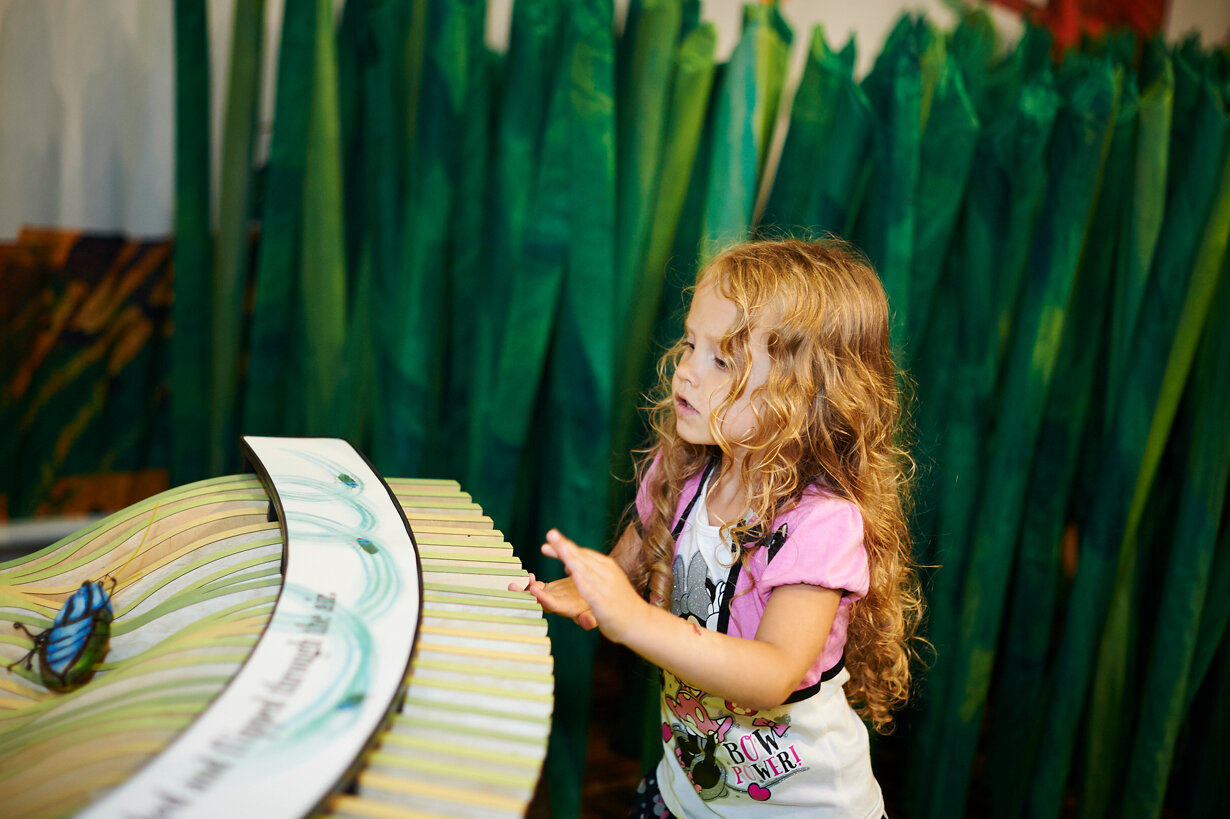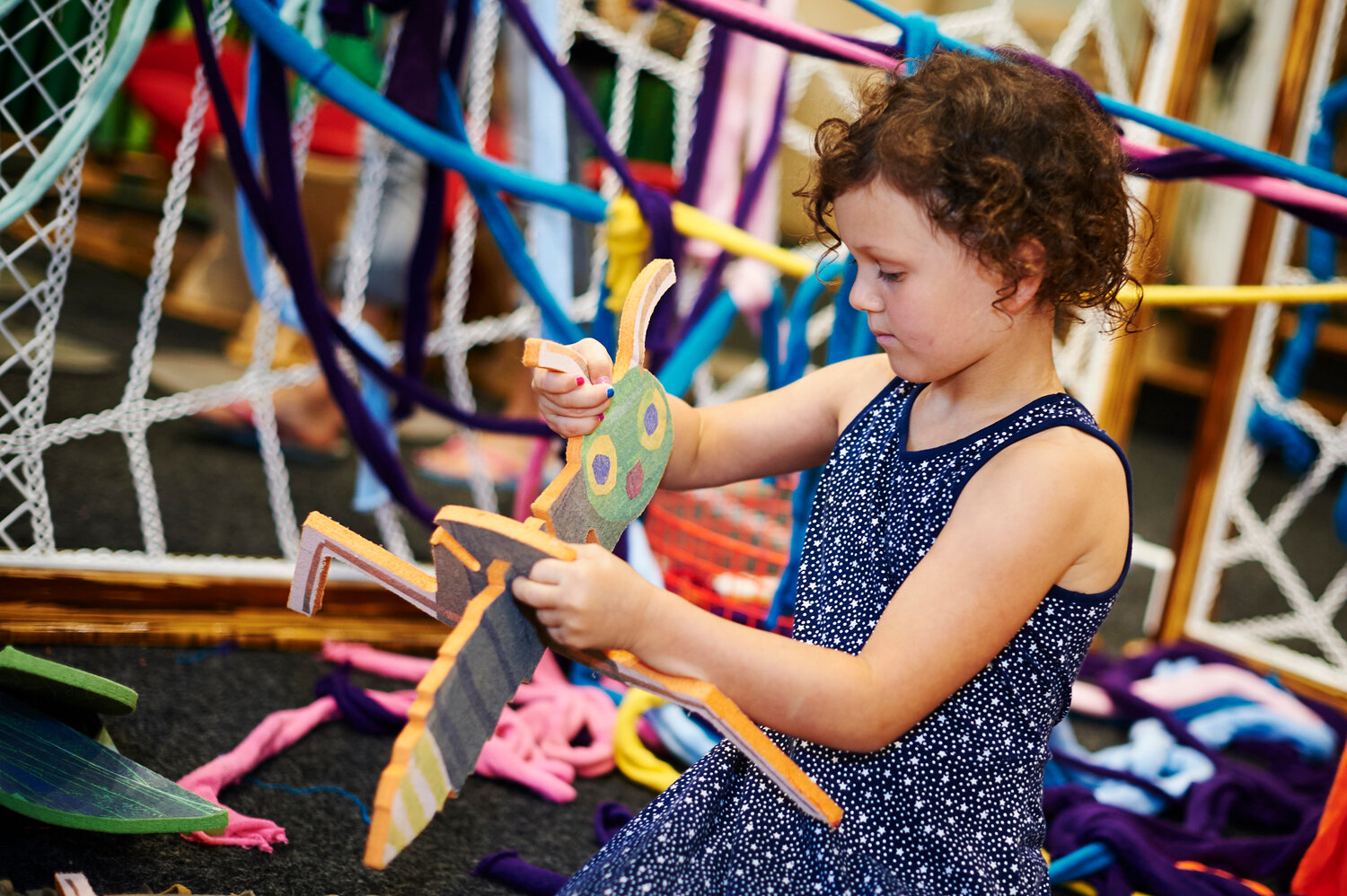Become a bookish bug at Long Island Children's Museum
Discover Eric Carle’s tiny world of insects in new sensory adventure
"In the light of the moon, a little egg lay on a leaf."
That’s how the journey started for Eric Carle’s Very Hungry Caterpillar, the beloved character from his acclaimed picture book of the same name. Now, Long Island Children’s Museum takes the magnifying glass to Carle’s curious bugs in its newest exhibit, “Very Eric Carle: A Very Hungry, Quiet, Lonely, Clumsy, Busy Exhibit.”
Created by the Pittsburgh Children’s Museum and The Eric Carle Museum of Picture Book Art, it’s a follow-up of sorts to last year’s popular Mo Willems exhibit, which also encouraged kids to step into the creative imagination of a beloved author-illustrator.
Visitors find themselves inside the pages of Carle’s colorful books. His “Very” series — all illustrated in his hand-painted tissue paper collage technique — introduces five special insects who take journeys of discovery. Each story is a testament to Carle’s love of nature along with his recurring themes of friendship, creativity, and the power of imagination.
The colorful picture books — more than 70 in all — have been captivating young children since Carle’s first publishing effort, the counting book “1,2,3 to the Zoo,” in 1968.
From there, his “Very” books took off the following year, beginning with the one that started it all, “The Very Hungry Caterpillar,” of course. Families were immediately captivated by Carle’s little bugs with big emotions.
There’s a deep-felt connection to the insects, according to Ashley Niver, the museum’s education director.
“Children have a fascination with things that are even smaller than they are because they’re usually the ones looking up at the world,” she said. “I find that they have a lot of care and concern for these small living things. They enjoy the roleplay of being a friend of one or becoming one, like wearing the wings of a butterfly and flying around.”
And, naturally, the insatiable caterpillar holds a special place in everyone’s hearts.
“We’ve had parents mention that they read ‘The Very Hungry Caterpillar’ as a child and now they are reading it to their child,” Niver says. “The messaging is something that resonates.”
The exhibit may be indoors, but the focus is fully on the outside world, exploring the diversity of the insect kingdom through Carle’s imagination.
“A lot of people relate to ‘The Very Hungry Caterpillar,’ but there are a lot of other lovely stories,” Niver says. “I don’t think that everyone is as well-versed in some of his other books, so I’m happy that this features some more of them.”
Tumble in the grass, weave a web, find a friend, and even become a butterfly during your visit.
Upon arrival, visitors can follow the Very Hungry Caterpillar’s path on a journey through larger-than-life pages of the book, eating foods on the way to becoming a butterfly. Once the end is reached, you’re now ready to spread your wings.
The Very Busy Spider component includes a giant, web-like structure to step through. This activity tests dexterity, strength and flexibility as kids move across the challenging surface.
At the Very Busy Spider’s Weaving Wall everyone can try to spin their own web on the large wall, experimenting with a variety of stringy materials.
Master new skills at the Very Clumsy Click Beetle Playscape. Here, visitors rummage across a pile of pebbles, crawl through tall blades of grass, step across stepping stones, and walk across the stem of a poppy flower in this playful landscape. Step up to the challenge and persevere like The Very Clumsy Click Beetle.
Also try to catch some light at the Very Lonely Firefly “Find Your Light” interactive station. Move hands and body to lure a firefly toward you. Even work with others to attract multiple fireflies and try to form a group of the beautifully lit insects.
At another component, kids can touch The Very Quiet Cricket and his friends on a relief mural to trigger a sound and create a one-of-a-kind musical composition. The various insect sounds harmonize together to make a “symphony” comprised of rhythms and sounds found in nature.
The exhibit’s studio portion offers up facts about Carle’s life and artistic process.
“Yellow was his favorite color,” Niver says. “Yellow was always the most challenging for him, which I thought was a cool fact. He only mastered four shades of yellow.”
After all that busyness being a bug, families may want to relax by taking a moment to read some books. The nook area is a cozy spot where everyone can nuzzle up in a reading cocoon and read the “Very” stories together.
Through his stories, Carle reminds us: “Simplify, slow down, be kind. And don’t forget to have art in your life — music, paintings, theatre, dance and sunsets.”









